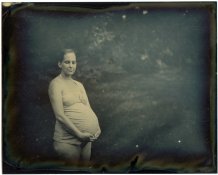bvy
Member
I've been reading extensively lately about wet and dry plate processes, and I'm eager to get my hands wet (or dry). For dry plate, the Rockland Colloid Tintype Parlor Kit comes up a lot, almost exclusively. And while I think it might be the best introduction to these processes, I have some concerns.
The developer is reputed to last only one or two weeks. I don't always work this fast, and would rather regroup after each exposure and see what went wrong and how to improve. Is it possible to split the developer into eight one-shot portions (I have several small 2oz. glass bottles with polyseal caps). The $35 kit comes with eight 4x5 plates and an unspecified amount of developer that should be used undiluted. Are there other ways to extend the working life of the developer (besides the obvious: glass containers, filled-to-capacity, etc.)?
I'm more concerned about the results I'm likely to get. Most of the things people post from the kit are not very impressive -- dull, flat, and with poor contrast. The better ones have bright yellow highlights, but it's hard to know what people are doing in their workflows for web display. So I'm only excited about the kit insofar as I'll be learning the process -- and perhaps as a stepping stone to custom formulations or wet plate. Still, I'd like to get something at least halfway rewarding. Can someone comment on the best way to get good contrast from the supplied materials? I understand their formulations changed recently (past ten years) to exclude formalin which had a significant impact on the contrast.
Thank you.
The developer is reputed to last only one or two weeks. I don't always work this fast, and would rather regroup after each exposure and see what went wrong and how to improve. Is it possible to split the developer into eight one-shot portions (I have several small 2oz. glass bottles with polyseal caps). The $35 kit comes with eight 4x5 plates and an unspecified amount of developer that should be used undiluted. Are there other ways to extend the working life of the developer (besides the obvious: glass containers, filled-to-capacity, etc.)?
I'm more concerned about the results I'm likely to get. Most of the things people post from the kit are not very impressive -- dull, flat, and with poor contrast. The better ones have bright yellow highlights, but it's hard to know what people are doing in their workflows for web display. So I'm only excited about the kit insofar as I'll be learning the process -- and perhaps as a stepping stone to custom formulations or wet plate. Still, I'd like to get something at least halfway rewarding. Can someone comment on the best way to get good contrast from the supplied materials? I understand their formulations changed recently (past ten years) to exclude formalin which had a significant impact on the contrast.
Thank you.



 ) in relation to drying the plates. Unfortunately, I don't have a light lock in my darkroom, so drying them out in the open for extended periods will be troublesome. How are you drying them bvy?
) in relation to drying the plates. Unfortunately, I don't have a light lock in my darkroom, so drying them out in the open for extended periods will be troublesome. How are you drying them bvy?
